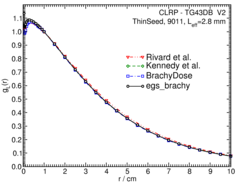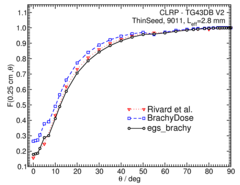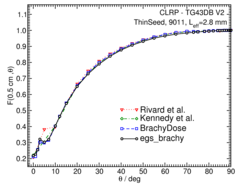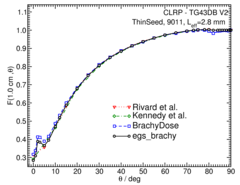
Source Description:
Source dimensions for the 9011 seed1,2 are taken from the paper by Kennedy et al 1 and Rivard et al 2. The 9011 source consists of a radio-opaque silver marker coated with a 1.75 μm thick layer of radioactive AgI and AgBr (2.5:1 molecular ratio of AgI:AgBr and a density of 6.2 g/cm3). The silver marker is a 2.80 mm long cylindrical silver (density of 10.5 g/cm3) rod with a 0.15075 mm (0.1525 mm with coating) radius. The ends of the silver marker are conical sections bevelled at 45.0o and the end faces of the rod have a radius of 0.175 mm. The silver marker is encapsulated in a 4.00 mm long titanium (density of 4.54 g/cm3) tube with 0.057 mm thick walls, a 0.255 mm outer radius and 0.255 mm thick hemi-spherical end welds. The space between the encapsulation and the marker contains argon gas (density of 1.784 mg/cm3). The overall source length is 4.55 mm and the active length is 2.80 mm. The mean photon energy calculated on the surface of the source is 27.26 keV with statistical uncertainties < 0.013%
Dose-Rate Constant - Λ :
Dose-rate constants, Λ , are calculated by dividing the dose to water per history in a (0.1 mm)3 voxel centered on the reference position, (1 cm,Π/2), in a 30x30x30 cm3 water phantom, by the air-kerma strength per history (scored in vacuo). As described in ref. 2 , dose-rate constants are provided for air-kerma strength calculated using voxels of 2.66x2.66x0.05 cm3 (WAFAC) and 0.1x0.1x0.05 cm3 (point) located 10 cm from the source. The larger voxel size averages the air kerma per history over a region covering roughly the same solid angle subtended by the primary collimator of the WAFAC 3,4 at NIST used for calibrating low-energy brachytherapy sources and is likely the most clinically relevant value. The small voxel serves to estimate the air kerma per history at a point on the transverse axis and includes a small 1/r2 correction (0.5%)3. egs_brachy and BrachyDose MC uncertainties are only statistical uncertainties (k=1).
| Author | Method | Λ (cGy h-1 U-1) | Abs. Uncertainty |
| Safigholi et al 6 | WAFAC | 0.9291 | 0.0001 |
| Safigholi et al 6 | point | 0.9318 | 0.0025 |
| Kennedy et al 1 | MCNP WAFAC | 0.923 | 0.004 |
| Kennedy et al 1 | MCNP Point | 0.928 | 0.004 |
| Kennedy et al1 | TLD in PMMA | 0.940 | 0.055 |
| Rodriguez, Rogers 7 | WAFAC (BrachyDose) | 0.930 | 0.002 |
| Rivard et al 2 | MCNP | 0.914 | 0.021 |
| Mason et al 8 | MC MCNPX | 0.926 | --- |
| Rivard et al 9 | TG43U1S2 consensus value | 0.933 | 0.028 |
Radial dose function - g(r):
The radial dose function, g(r), is calculated using both line and point source geometry functions and tabulated at 36 different radial distances ranging from 0.05 cm to 10 cm. Fit parameters for a modified polynomial expression are also provided10. The mean residual deviations from the actual data for the best fit were < 0.06%.
Click image for higher res version| Fitting coefficients for g L (r) = (a0 r-2 + a1 r-1 + a2 + a3r + a4r2 + a5 r3) e-a6r | |||
| Fit range | Coefficients | ||
| r min (cm) | r max (cm) | ||
| 0.03 | 10.00 | a0 / cm2 | (3.850+/-0.017)E-04 |
| a1 / cm | (-1.329+/-0.006)E-02 | ||
| a2 | (1.1519+/-0.0005)E+00 | ||
| a3 / cm-1 | (4.37+/-0.04)E-01 | ||
| a4 / cm-2 | (-7.0+/-0.7)E-03 | ||
| a5 / cm-3 | (2.45+/-0.09)E-03 | ||
| a6 / cm-1 | (4.544+/-0.028)E-01 | ||
Anisotropy function - F(r,θ):
Anisotropy functions are calculated using the line source approximation and tabulated at radii of 0.1, 0.15, 0.25, 0.5, 0.75, 1, 2, 3, 4, 5, 7.5 and 10 cm and 32 unique polar angles with a minimum resolution of 5o. The anisotropy factor, φan(r), was calculated by integrating the solid angle weighted dose rate over 0 o ≤ ϑ ≤ 90o.
Click images for higher res versionsTabulated data:
Tabulated data are available in .xlsx format: Excel
References:
1. R. M. Kennedy et al , Experimental and Monte Carlo Determination of the TG-43 dosimetric parameters for the model 9011 THINSeedTM brachytherapy source, Med. Phys., 37 , 1681 - 1688, 2010
2. M. J. Rivard, Monte Carlo radiation dose simulations and dosimetric comparison of the model 6711 and 9011 125I brachytherapy sources, Med. Phys., 36 , 486 - 491, 2009
3. R. E. P. Taylor et al , Benchmarking BrachyDose: voxel-based EGSnrc Monte Carlo calculations of TG-43 dosimetry parameters, Med. Phys., 34 , 445 - 457, 2007
4. R. Loevinger, Wide-angle free-air chamber for calibration of low-energy brachytherapy sources, Med. Phys., 20 , 907, 1993
5. S. M Seltzer et al , New National Air-Kerma-Strength Standards for 125 I and 103 Pd Brachytherapy Seeds, J. Res. Natl. Inst. Stand. Technol., 108 , 337 - 358, 2003
6. H. Safigholi, M. J. P. Chamberland, R. E. P. Taylor, C. H. Allen, M. P. Martinov, D. W. O. Rogers, and R. M. Thomson, Updated of the CLRP TG-43 parameter database for low-energy photon-emitting brachytherapy sources, to be published (Current calculation).
7. M. Rodriguez , D. W. O. Rogers, Effect of improved TLD dosimetry on the determination of dose rate constants for 125I and 103Pd brachytherapyseeds, Med.Phys. 41, 114301-15, 2014
8. Mason J, Al-Qaisieh B, Bownes P, Henry A, Thwaites D, Monte Carlo investigation of I-125 interseed attenuation for standard and thinner seeds in prostate brachytherapy with phantom validation using a MOSFET, Med Phys. 2013;40:031717 9. M. J. Rivard et al , Supplement 2 for the 2004 update of the AAPM Task Group No. 43 Report: Joint recommendations by the AAPM and GEC-ESTRO, Med. Phys., 44 , e297-e338, 2017
10. R. E. P. Taylor, D. W. O. Rogers, More accurate fitting of 125I and 103Pd radial dose functions, Med. Phys., 35 , 4242-4250, 2008.
Back to seed index
Carleton Laboratory for Radiotherapy Physics
CLRP TG-43 Parameter Database V2
May 5, 2020




